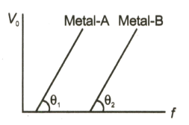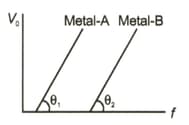Embibe Experts Solutions for Exercise 2: EXERCISE 11.2
Embibe Experts Physics Solutions for Exercise - Embibe Experts Solutions for Exercise 2: EXERCISE 11.2
Attempt the free practice questions from Exercise 2: EXERCISE 11.2 with hints and solutions to strengthen your understanding. Gamma Question Bank for Engineering Physics solutions are prepared by Experienced Embibe Experts.
Questions from Embibe Experts Solutions for Exercise 2: EXERCISE 11.2 with Hints & Solutions
Consider the graph between stopping potential versus frequency of incident light shown here for two different metals.

Which of the metals has higher value of work function?
Consider the graph between stopping potential versus frequency of incident light shown here for two different metals.

If work function of metal. is times the work function of metal , what is the relation between and
In a photoelectric emission the stopping potential is plotted against the frequency of incident light. The resulting curve is a straight line which makes an angle with the -axis. Then will be equal to ( work function
The stopping potential are and with incident lights of wavelengths and respectively. Then equal to
When a certain metallic surface is illuminated with light of wavelength , the stopping potential is . When the same surface is illuminated with light of wavelength , the stopping potential is . The threshold wavelength for this surface is
A proton and an -particle are accelerated through the same potential difference. The ratio of de-Broglie wavelength of the proton to that of the particle will be
The work functions of silver and sodium are and , respectively. The ratio of the slope of the stopping potential versus frequency plot for silver to that of sodium is
In a photoelectric experiment, a parallel beam of monochromatic light with the power of is incident on a perfectly absorbing cathode of work function . The frequency of light is just above the threshold frequency so that the photoelectrons are emitted with negligible kinetic energy. Assume that the photoelectron emission efficiency is . A potential difference of is applied between the cathode and the anode. All the emitted electrons are incident normally on the anode and are absorbed. The anode experiences a force due to the impact of the electrons. The value of is? Mass of the electron and .
